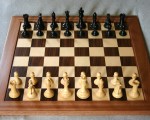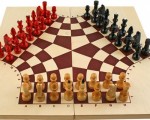Level Design is Game Design!
Have I got your attention? Alright, so I admit the two are not perfectly the same but I am convinced that Level Design is nothing but a specialized application of Game Design. And I can prove it! First let’s start by looking at a pretty okay definition of Level Design:
Level Design is the process of designing and implementing the digital spaces of a video game
Sounds simple enough, right? Of course if we were scientific about this we’d have to take a closer look at what digital spaces are. However that’s beyond the scope of this article and will be something I’ll talk about another time. For now let’s look at board games. Why? Because they’re quite similar to video games and because it makes it a lot easier to understand the topic.
 Now with board games, you have the rules of the game, which encompass how pieces can move, how a turn plays out and what the victory conditions are. The other half of that puzzle is the design of the actual board, which could be seen as the level design of the game. It’s evident that when the board is changed, the entire game changes with it. Imagine a game of chess, where the board is not 8×8 fields but instead 8×12 or maybe something more outlandish like an L shape. This will drastically change how the game is played. The same is true when a level is changed.
Now with board games, you have the rules of the game, which encompass how pieces can move, how a turn plays out and what the victory conditions are. The other half of that puzzle is the design of the actual board, which could be seen as the level design of the game. It’s evident that when the board is changed, the entire game changes with it. Imagine a game of chess, where the board is not 8×8 fields but instead 8×12 or maybe something more outlandish like an L shape. This will drastically change how the game is played. The same is true when a level is changed.
 So if you think about it, the game space is nothing but another set of rules. They’re just visualized as a space to make it easier for us. Instead of rolling a die and tracking the movement pieces on a board, we could simply use numbers to denote a token’s position. Say if you’re on field “3” and roll a 5, you wouldn’t move your piece 5 spaces, you’d write down “8” instead. And then if there’s “special fields” you’d have a table where you could look up the number and see if there are any special rules for it. It’s obvious that this is a lot more complicated than moving a piece on the board, which is why we use spaces for a lot of our board games.
So if you think about it, the game space is nothing but another set of rules. They’re just visualized as a space to make it easier for us. Instead of rolling a die and tracking the movement pieces on a board, we could simply use numbers to denote a token’s position. Say if you’re on field “3” and roll a 5, you wouldn’t move your piece 5 spaces, you’d write down “8” instead. And then if there’s “special fields” you’d have a table where you could look up the number and see if there are any special rules for it. It’s obvious that this is a lot more complicated than moving a piece on the board, which is why we use spaces for a lot of our board games.
So if game spaces are just rules why is there a split between game and level design? There is no such thing in board game design, right? Well the answer’s simple: In the early days of game development there was no seperation: there often was just one person making the entire game, designing the rules, the spaces, the graphics and the sounds. But Because the increasing amount of content and complexity required specialization we now have different people doing different parts of the same job.
So with all that said, let’s look at that definition again:
Level Design is the process of designing and implementing the (spatial) rules of a video game
And let’s look at Wikipedia’s definition of Game Design
Game Design is the process of designing the content and rules of a game
Sounds awfully similar, doesn’t it? There’s just a few differences:
- Level Design only deals with those game rules which are manifested as spaces
- Level Design is also responsible for the implementation of these rules in the game
- Level Design only really exists as a discipline in the realm of video games
I rest my case.

I think that Game Design and Level Design are dependent on one another. For example, a puzzle game like Goof Troop for the SNES will have rules such as picking up objects, throwing and dropping them. But for those rules to be used effectively, the Level itself must form the puzzle for which the rules will be applied to.
Another example is in any FPS game the player is usually bound by rules such as running, jumping, taking cover, and aiming (shooting) , but the Level will be tailored to emphasize the rules and create the experience the design has laid out.
I guess a way of looking at it is that Level Design is a subset of Game Design – a large one at that – and without proper Level Design , the Game Design will fail.
I certainly agree with your core idea: Successful / good level design needs to be in tune with the game design. That’s a pretty basic concept but so important. If you have a game feature that’s used only used at one place in one level, then that’s usually not such a good idea.
On the other hand I’m not so sure if Level Design is a “subset” of Game Design. Granted I was a bit polemic with my statement above but I think it’s more that the two disciplines have a lot of overlap instead of one being a subset of the other. If you think about it, each one has their unique elements. Like fiddling with the visuals of a level – that’s certainly not “game design” in the sense that it does not establish any game rules, not even spatial ones. Thinking about board games: It makes no difference wether the board is green or red, the gameplay is the same, right?
Pingback: Game Architecture » Level Design is Game Design | boardgame
Agreed. (That’s all I have to say, since you said already everything worth saying…) Great article!
Pingback: Games Development and Gaming in the World Today « WETONG Blog
i was wondering if you knew how i could find someone who designs games im 15 and have an idea for a new game but not for sure if it would be any good
Pingback: Game Architecture » The three Qualities of Level Design
Pingback: Sonic The Hedgehog- A Video Game Masterpiece | Vintage Video Games
Think about checkers vs chess. Each have the same board yet the games are completely different. It is the pieces and what they are able to do that sets these games apart. Those piece abilities are truly what game design seeks to create. Game design or more like ‘rules design’ tells a player what they can and cannot do on an open field. Level design puts those abilities in context, creating a challenge that the player must fight. A harmony of rules and level design will result in a game that challenges players and encourages them to use all of the abilities available to them. Thus, if moving the pieces is fun and the level design works with those pieces, then the game will be fun. The best videogame example I can think of is Team Fortress 2. Everywhere, distance, cover, and paths work to ensure equality within very different classes. The areas inside the bases on two fort without roofs are common places for engineers two place turrets over. The far steps are the exact length for a skillful scout to run up without giving enough time for a turret to lock on. As seen in Team Fortress, rules design and level design both work together (or against in unsuccessful cases) to create a cohesive game. A creator must fully understand the intent of both types within a game.
Pingback: Role of a level designer | hassan1207922